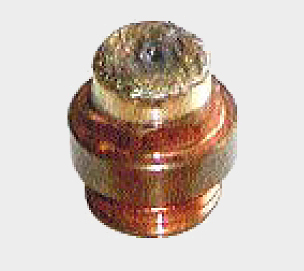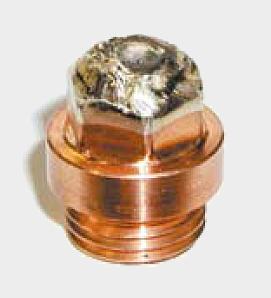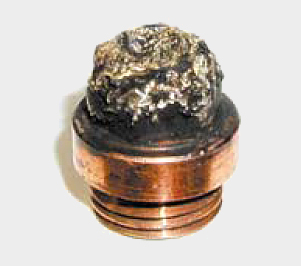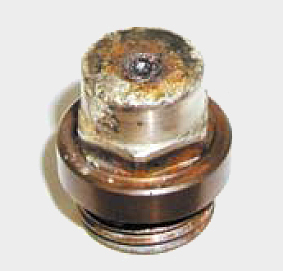Electrode Wear in Air & Oxygen Plasma
Electrodes for high power plasma cutting systems are highly engineered consumable parts, similar in design, material, and function to an automotive spark plug. Like spark plugs, electrodes emit high voltage electricity in a very hot environment. The materials must withstand plasma temperature arc emissions, endure swirling high velocity gas jets, and provide a hermetic seal to high-pressure gases and fluids. The electrode, like a spark plug, is the hardest working part in the system.
A good mechanic can tell a lot about the health of a combustion engine by looking at the spark plugs. A trained plasma technician can do the same for a plasma system if he learns how to inspect the electrode, understands normal wear patterns, and knows how to spot signs of trouble.
The electrode carries the DC power from the plasma power supply to the metal plate. It is typically comprised of a copper or copper/silver composite holder that contains an emissive element of hafnium-a high melting point metal that will sustain an arc in air and oxygen cutting environments. The emitting element is slowly eroded away by the heat of the arc, and the high velocity plasma gas stream. Most of this wear occurs at the start and stop of a cut when the molten hafnium material quickly heats up and cools down, melting then re-solidifying.
During normal wear a small concave pit is formed in the end of the part that steadily wears away, a few thousandths of an inch at a time, to a depth of .040" to .125" deep depending on the torch and consumable design and materials. When the pit becomes too deep, the arc attaches to the holder material and melts it. The electrode "fails" when it will no longer initiate and sustain an arc. If molten material from the electrode is deposited downstream into the bore of the nozzle it causes a "blowout"-catastrophic failure of both the electrode and nozzle.
Normal parts life for state-of-the-art oxygen plasma systems is 1-2 hours of arc-on time and 200-300 pierces. Air systems can typically achieve twice this life, 400-600 starts, because the nitrogen component of air makes it less reactive with the electrodes. Oxygen plasma systems with inert start gases and current ramping can reach 1000 or more starts before an electrode change is necessary.

1. Normal wear pattern. The hafnium pit is well centered and uniform in shape, indicating good alignment of consumables and a proper plasma gas swirl. The depth of the pit is approximately 1.6mm (HiFocus 160i). The front edges of the part are sharp and distinct; there is no severe discoloration of the silver. Some grayish colored oxides on the front surface of the part are normal.

2. Off-centre burn. This is an easy problem to spot. It usually indicates a severe gas flow problem (such as a clogged swirl ring) or a misalignment of the torch parts (due to assembly errors and fit up problems). If a complete change of torch parts doesn't correct the problem, the torch is probably damaged.

3. Moisture on start. Moisture was present during starting of the arc. Moisture in the preflow gas causes the high frequency to attack the silver material. Front edges of silver not sharp; smoothed over with a "sandblasted" surface condition. Check preflow gas for signs of moisture. One quick cheque is the paper towel test. Hold a clean paper towel under the torch with gas flowing through the system. There should be no sign of moisture.

4. Low pre-flow. Insufficient gas during arc initiation allows a "lazy start". The arc spends too long traveling from the start point (usually a sharp corner) to the emitting element. These parts will have a fairly uniform ring of molten holder material surrounding the pit. The surface may appear like a solder splash or weld puddle has formed along the front of the part.

5. Blow out. This electrode has been run to catastrophic failure. Since the electrode is upstream, it will cause damage to the nozzle when molten material is blown out of the end of the part and deposited into the nozzle interior. If run long enough, all parts will fail in this way.

6. Low plasma gas (Snuffing). This electrode has small pockmarks all over the end of the part with corresponding damage to the interior of the nozzle, low gas flow is indicated. Low gas flow allows uncontrolled arcing between the nozzle and electrode. Check the gas flow rates to the torch.

7. Excessive gas flow. If the nozzle is in good condition but the electrode has a deep concentric pit the plasma gas flow rate may be too high. If the plasma gas swirl is too intense, the element is eroded quickly. This causes a rapid deep wear pattern. Check the flow rate of the plasma gas.
-By D. Cook and J. Start- Article originally appeared in "Practical Welding Today " - May/June 2002
This article won the American Society of Business Publication Editors (ASBPE) BRONZE AWARD for Editorial Excellence.








